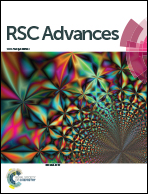Bis-resorcin[4]arene–bridged porphyrin conjugates: synthesis, fluorescence and binding studies†
Abstract
In this study, three bis-resorcin[4]arene–bridged porphyrin conjugates were synthesised from 5-15-di(3-hydroxyphenyl)-10,20-di(4-toluyl)porphyrin (PT), 5,10-di(3-hydroxyphenyl)-15,20-di(4-toluyl)porphyrin (PC) and 5-(3,5-dihydroxyphenyl)-10,15,20-tri(4-toluyl)porphyrin (PH), respectively; porphyrins PT, PC and PH were synthesised by the condensation of their corresponding aldehydes with pyrrole in propionic acid. In addition, the single-crystal X-ray diffraction analysis of the resorcin[4]arene host as well as the binding behaviour and fluorescence decay studies of the bisresorcin[4]arene–porphyrin conjugate are reported. Moreover, zinc derivatives of the three resorcin[4]arene–porphyrin conjugates, are synthesised. Binding studies conducted via UV-vis titration revealed that compared to the association constant (Ka) for free zinc-porphyrin (ZnTTP), those for bis-resorcin[4]arene–bridged porphyrin conjugates are higher, with an increase of approximately 50%. The fluorescence quenching of porphyrin is considerably enhanced by the attachment of resorcin[4]arene to the photoactive subunit; however, the efficiency of fluorescence quenching is affected by the structure type of porphyrin bis-conjugates.
![Graphical abstract: Bis-resorcin[4]arene–bridged porphyrin conjugates: synthesis, fluorescence and binding studies](/en/Image/Get?imageInfo.ImageType=GA&imageInfo.ImageIdentifier.ManuscriptID=C6RA13963A&imageInfo.ImageIdentifier.Year=2016)

 Please wait while we load your content...
Please wait while we load your content...